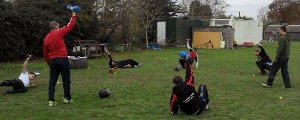Main Menu
Latest Blog Entry
User login
How to start coaching strength and conditioning
“How can you demonstrate if you have never done the exercise?”
 was one of the questions I asked the candidates on the Level 1 strength and conditioning course at the weekend.
was one of the questions I asked the candidates on the Level 1 strength and conditioning course at the weekend.
Reading a text book or journal is one thing, setting up a good plan is another. Delivering and executing that plan, then being able to adapt it is where coaching is difficult.
There was a blend of youth and experience on the course, with 5 students and 5 people who work. As always, I started off with trying to establish coaching language used in order to dismiss folklore and create better understanding.
 However, one of the candidates thought that my insistence on using simple coaching cues actually complicates matters! This came up in our discussion on how to communicate effectively when coaching.
However, one of the candidates thought that my insistence on using simple coaching cues actually complicates matters! This came up in our discussion on how to communicate effectively when coaching.
Once again, language is important so we avoid doing “rotator cuff” dumbbell exercises (which have nothing to do with our rotator cuff works in real life) rather than thinking about the movements that our sport requires and training our shoulders accordingly (shoulder exercise video)
Walking the walk
As usual, over half the course was based on practical learning and delivery. I try to work from the premise of creating structural integrity with our athletes, then progressing to developing movement efficiency.
It is quite concerning to see young people who are in pain and who lack the ability to perform fundamental movements such as squatting, skipping and balancing on one leg.
Without these basic skills, it is hard to move fast, or sustain movement without getting injured. I took the candidates through a series of exercises and progressions that will help remedy this. We then applied this in speed and agility work.
 Again, I kept this simple, but concentrated on coaching it thoroughly. The principles can then be applied to whatever other drill the candidates choose to use in their environments.
Again, I kept this simple, but concentrated on coaching it thoroughly. The principles can then be applied to whatever other drill the candidates choose to use in their environments.
I have to be patient and realise that young people are a product of their environment and are just starting out on their coaching pathway.
Further reading:
Client Testimonials
 Blundells School
Blundells School
James has a huge breath and depth of knowledge on fitness issues. He is able to implement this knowledge into a practical course both making the task of fitness and conditioning both different and interesting from other fitness training that most are familiar with. He understands the safety issues when dealing with young adults strength and conditioning programmes. Programmes he sets are tailored to the individual needs of the group. There was a huge amount of progress made with some of these individuals in terms of their understanding of fitness and their own fitness levels.
More


Comments
[…] a level 1 strength and conditioning course […]